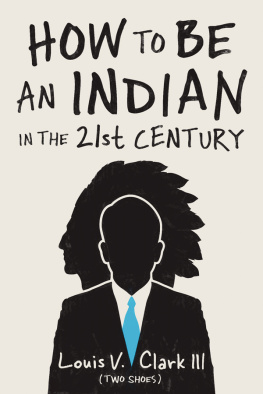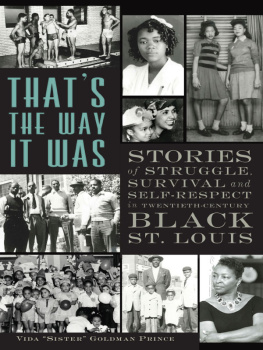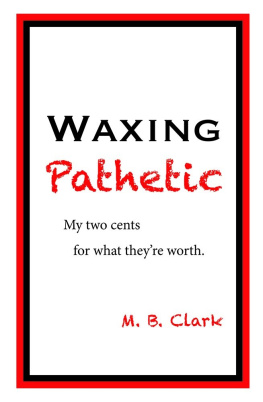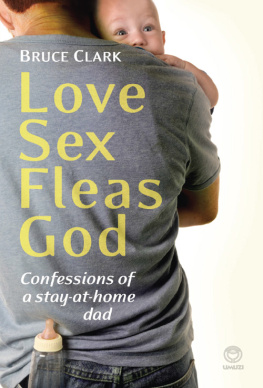How to Be an Indian in the 21st Century
(Continuing the Oral Tradition)
Tales of an Iroquois Storyteller
 LOUIS V. CLARK III
LOUIS V. CLARK III(Two Shoes)
WISCONSIN HISTORICAL SOCIETY PRESS Published by the Wisconsin Historical Society Press
Publishers since 1855 The Wisconsin Historical Society helps people connect to the past by collecting, preserving, and sharing stories. Founded in 1846, the Society is one of the nations finest historical institutions.
Order books by phone toll free: (888) 999-1669
Order books online: shop.wisconsinhistory.org
Join the Wisconsin Historical Society: wisconsinhistory.org/membership 2017 by Louis V. Clark III E-book edition 2017 For permission to reuse material from
How to Be an Indian in
the 21st Century (ISBN 978-0-87020-815-7; e-book ISBN 978-0-87020-816-4), please access www.copyright.com or contact the Copyright Clearance Center, Inc. (CCC), 222 Rosewood Drive, Danvers, MA 01923, 978-750-8400. CCC is a not-for-profit organization that provides licenses and registration for a variety of users.
Cover art inspired by an illustration by the author. Designed by Percolator Graphic Design 21 20 19 18 17 1 2 3 4 5 Library of Congress Cataloging-in-Publication Data Names: Clark, Louis V., III, author. Title: How to be an Indian in the 21st century / Louis V. Clark III (Two Shoes). Description: Madison : Wisconsin Historical Society Press, [2017] Identifiers: LCCN 2016034794 (print) | LCCN 2016036065 (e-book) | ISBN 9780870208157 (pbk. paper) | ISBN 9780870208164 (e-book) | ISBN 9780870208164 (E-book) Subjects: LCSH: Clark, Louis V., III. | Clark, Louis V., IIIPoetry. | Oneida IndiansWisconsinBiography. | Oneida IndiansPoetry. | Indians of North AmericaWisconsinBiography. | Indians of North AmericaWisconsinBiography.
Classification: LCC PS3603.L36526 Z46 2017 (print) | LCC PS3603.L36526 (e-book) | DDC 811/.6 [B]dc23 LC record available at https://lccn.loc.gov/2016034794 To Debra Lee Grace (VanEnkevort) Clark
Contents
Traditional Oneida Thanksgiving Prayer Now listen to the words that come before all else. We bring together our minds and give thanks to one another. So be it our minds. We bring together our minds and give thanks to our Mother the Earth, for the life she gives. So be it our minds. We bring together our minds and give thanks for the first fruits that grow, the strawberry.
So be it our minds. We bring together our minds and give thanks for all the medicines. So be it our minds. We bring together our minds and give thanks to the tobacco we use to send our messages to the Creator. So be it our minds. We bring together our minds and give thanks to all the different animals that help sustain our lives.
So be it our minds. We bring together our minds and give thanks to all the different trees, the maple is the most special of all. So be it our minds. We bring together our minds and give thanks to all the waters great and small. So be it our minds. We bring together our minds and give thanks to all the different birds that entertain us.
So be it our minds. We bring together our minds and give thanks to the forces that work together with the earth, our Grandfathers the Thunders, who bring the rain to renew the earth. So be it our minds. We bring together our minds and give thanks to the eldest Brother the Sun, who gives us light and warmth. So be it our minds. We bring together our minds and give thanks to our Grandmother the Moon, she controls all the life cycles on earth.
So be it our minds. We bring together our minds and give thanks to the stars that are our relatives, they beautify the sky. So be it our minds. We bring together our minds and give thanks to the four messengers who give us guidance. So be it our minds. We bring together our minds and give thanks to the Creator of all, for it is the Creator who has brought us together as one.
So be it our minds. My name is Louis Clark. Louis Vincent Damian Clark III. They call me Two Shoes. I am of two worlds. My Fathers People were from Europe, from Poland.
My Mothers People were here waiting for them. I am one with the People of the Standing Stone. We are the Oneida Tribe of Indians of Wisconsin. I am a part of the Iroquois Confederacy, a member of the Bear Clan. I am guided by the Hawk. I started to write poetry when I was in the sixth grade.
Sixth-grade boys, who write poetry, on the reservation, inside of a Catholic school, They get beat up a lot! But there is poetry in the air on the reservation. It called to me. I can hear it in my head. I can hear it in my heart. I was schooled in the art of storytelling by my elders. Through the blue haze of cigarette smoke, around the kitchen table That served as our campfire, a world was opened to me.
Sometimes from deep inside of a beer bottle, brandy bottle, stark truths were shared. I share them with you. Understanding that humans are contradictory, And all good stories are partly truth and partly fiction. On the Fourth of July in Oneida, in my memories, Indians would gather. Indians from all over would gather at the ball diamond, located just one good baseball throw west of the Holy Apostles Church in Oneida, Wisconsin. Teepees would rise like the phoenix being reborn.
Tents, campfires, and logs for sitting could be seen outlining the baseball infield. Gathered around home plate would be the drums. Not the white man drums that you hear on television, Boom, boom boom boom! Boom, boom boom boom! No, these drums were Indian drums beating boom, boom, boom, boom, boom, boom, like a heartbeat, the heartbeat of my nation. They beat all day, they beat all night, and to a little Indian boy tucked inside his bed, those drums made him feel secure. So I wrote: 4th of July in Oneida Off in the distance In my memory I hear The drums, the drums, The drums drawing near The heartbeat of my nation That sounds this time of year The drums, the drums, The drums drawing near White mans Independence Day Old Glory waving clear The drums, the drums, The drums drawing near Father standing tall and proud On his breath a trace of beer The drums, the drums, The drums drawing near My future, my past My hopes and all my fears The drums, the drums, The drums drawing near My wife, my children My heritage to hold dear The drums, the drums, The drums drawing near In the sixth grade all my poems had the repeating word. Sadly, like my comic books and baseball cards, they were all thrown away.
I was born on the Oneida reservation, about five miles west of Green Bay, Wisconsin. It seemed I spent the first four or five years of my life being raised by my Gramma House, in a little shack on the south side of the tracks with no indoor plumbing. So I wrote this poem about my fear of going to the outhouse after dark: The Outhouse On the worn path With the blanket of Summer to cover us Mother Nature held Little boy secrets As we ran in the night. Came the snow That old trickster lady Betrayed our confidences Exposing our fears Along the path Grandma would tell us Of her sorrow Painted in yellow snow. Sadly, my heritage was almost thrown away. Our reservation was slowly disappearing.
My birth brought responsibilities to a youngster not yet home from the hospital. My older brother Daniel, who had died of crib death years earlier, was the firstborn male heir to the Clark name. It would be many granddaughters later before another male Clark entered the worldme. I was given the surname Clark, so for all practical purposes I was white. No one ever told me I was an Indian. The doctor didnt pull the baby out with those salad tongs and holler, Hey, an Indian.










 LOUIS V. CLARK III
LOUIS V. CLARK III